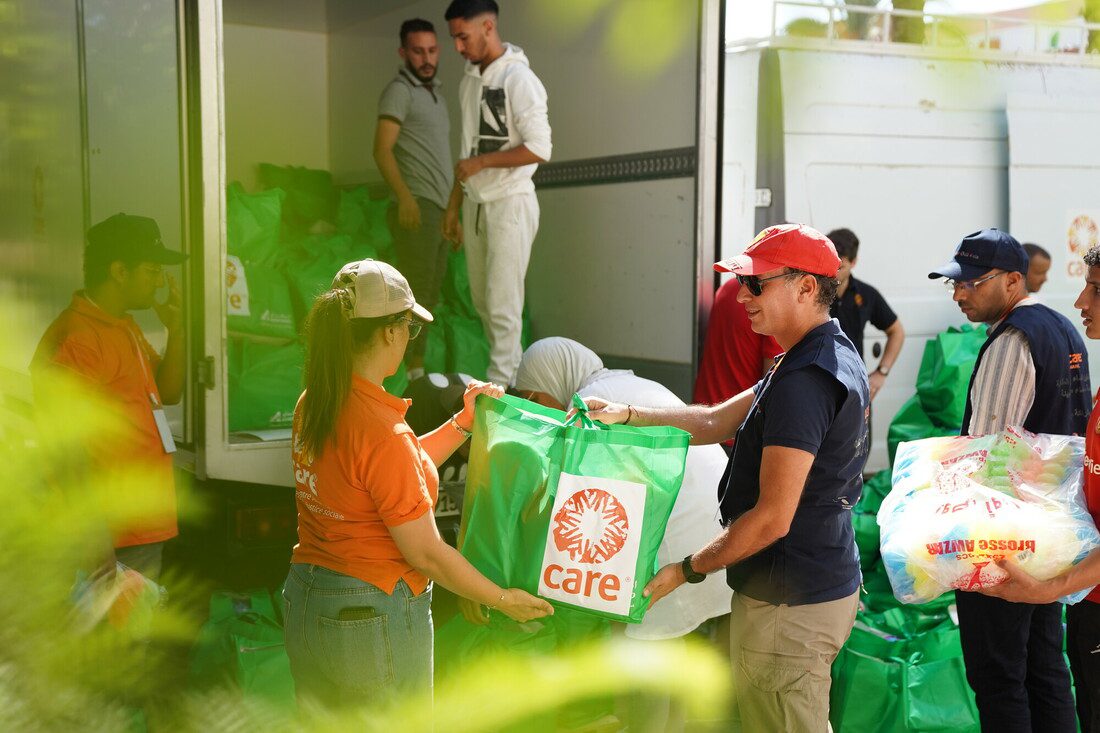On September 8, 2023, hundreds of thousands of people in Morocco were woken abruptly by a 6.8-magnitude earthquake that struck just before midnight. The earthquake was the strongest to hit the region in 120 years and could be felt nearly 100 miles away from the epicenter.
The earthquake devastated infrastructure in Al Haouz, Taroudant, Chichaoua, and Ouarzazate provinces and the Marrakesh area, levelling an estimated 59,674 homes and impacting 300,000 people overall. In addition to homes, the earthquake severely damaged or destroyed nearly 600 schools in the region, which will have devastating, long-term impacts on affected communities.
Despite significant efforts made by the authorities and emergency response organizations over the last six months, the affected communities still have a long journey ahead as they work to rebuild their lives.
Saida’s story
Saida is a mother of two children living in Tiguenziouine douar in Al Haouz region. She first learned about CARE three years ago when a women’s economic empowerment project started up in her neighbourhood that created Village Savings and Loan Association (VSLA) groups. She quickly joined a group called Nidae Al Khir, where she learned not only about the importance of savings, but also gained essential business skills, like how to balance a budget.
With a loan from the group and the help of a nearby women’s cooperative supported by CARE, Saida launched a small business making jam from the local fruit grown around her neighbourhood.
Business was going very well until the earthquake came and many of the buildings in her neighbourhood were destroyed in the blink of an eye.
Saida and 25 other women in her VSLA decided to turn this tragedy into an opportunity for action. They came together to help build temporary shelters and share what they could with families in need.
After coming across a humanitarian convoy on the road to her village, Saida volunteered to help with the emergency response in her area, acting as a liaison between local authorities, relief organizations and community members. Her resilience and leadership during this difficult time is a testament to how tragedy can also provide opportunities for unity and hope.


Saida, a woman leader, assists the women of her community in setting up tents in Douar Tiguenziouine, in the province of Al Haouz. CARE Morocco
CARE’s response to date
CARE has been working closely with the Government of Morocco, which continues to lead the humanitarian response to this catastrophe. In support of the government’s response, CARE began distributing kits to vulnerable families in Al Haouz province within days of the initial earthquake. As part of this first phase of our response, CARE has reached 12,056 people with food and other essential supplies, like hygiene and dignity kits in 21 villages.
Our initial assessments made it very clear that people in the earthquake-affected areas were in need of psychosocial support. In a matter of moments, many people lost everything—their homes, businesses, family members and friends. In the past six months, CARE and our partner Médecins du Monde have provided psychosocial support to 4,002 people.
Unfortunately, many people still suffer from insufficient shelter options six months after the earthquake. CARE has already distributed tents and other temporary shelter materials to 10 villages, supporting almost 4,000 people. Our teams aim to increase our distribution of shelter materials in the coming months to ensure the safety and dignity of earthquake-affected families as they begin the process of rebuilding their lives and livelihoods. CARE also initiated the distribution of non-food items, particularly blankets, reaching nearly 3,500 people across five villages.
At CARE we put women and girls at the centre of everything we do, including humanitarian response. Natural disasters, like the earthquake that struck Morocco, tend to impact women and girls differently and often more severely, than men and boys. Heightened uncertainty, lack of resources and insufficient shelter can lead to a rise in gender-based violence.
CARE is working towards creating safe spaces for women and girls. These safe spaces help prevent violence, support women and girls experiencing violence, and help relaunch income-generating activities.
Additionally, CARE has launched a project to restore preschool education, to help reinstate a sense of normalcy for children, as nearly 600 schools in the area were destroyed.
There is still considerable need for emergency assistance—experts estimate that reconstruction may take a decade, if not longer.


Moumen Aomari/CARE Moroccoo
CARE in Morocco
CARE has been working in the earthquake-affected areas of Morocco since 2008 with a focus on women’s economic empowerment activities. Over the years, we have developed strong relationships with local communities and multiple local partners, which has enabled us to better tailor our response to the local context and leverage local networks and resources. This locally–led approach will also help promote community ownership of the response activities, which will be critical, as the process of rebuilding homes, lives and livelihoods will take years.



